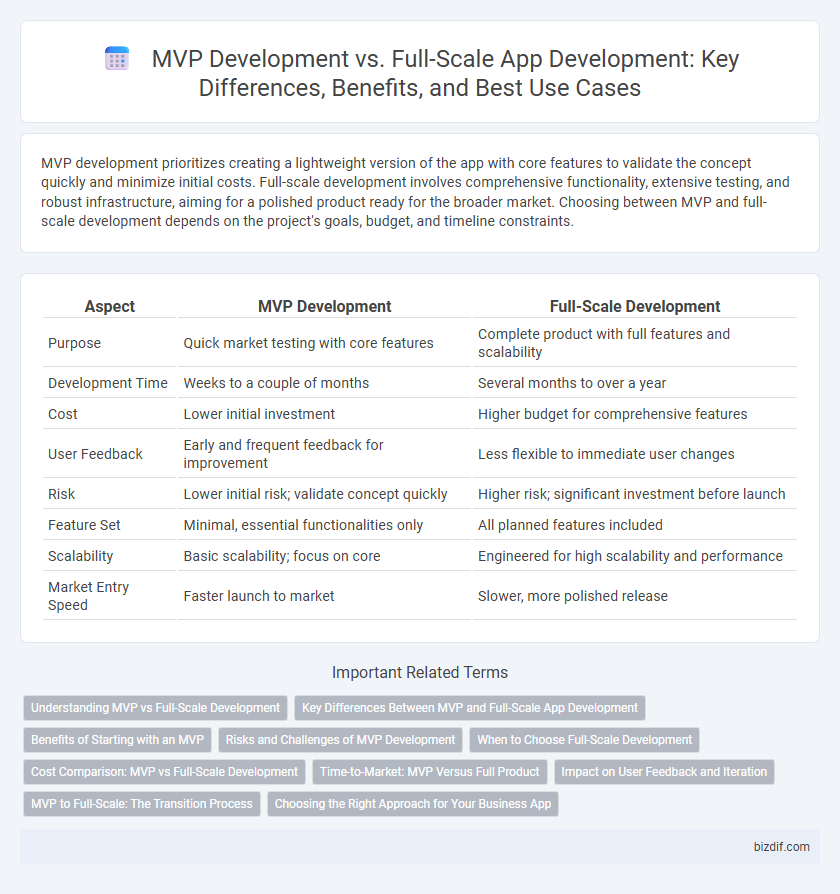MVP development prioritizes creating a lightweight version of the app with core features to validate the concept quickly and minimize initial costs. Full-scale development involves comprehensive functionality, extensive testing, and robust infrastructure, aiming for a polished product ready for the broader market. Choosing between MVP and full-scale development depends on the project's goals, budget, and timeline constraints.
Table of Comparison
| Aspect | MVP Development | Full-Scale Development |
|---|---|---|
| Purpose | Quick market testing with core features | Complete product with full features and scalability |
| Development Time | Weeks to a couple of months | Several months to over a year |
| Cost | Lower initial investment | Higher budget for comprehensive features |
| User Feedback | Early and frequent feedback for improvement | Less flexible to immediate user changes |
| Risk | Lower initial risk; validate concept quickly | Higher risk; significant investment before launch |
| Feature Set | Minimal, essential functionalities only | All planned features included |
| Scalability | Basic scalability; focus on core | Engineered for high scalability and performance |
| Market Entry Speed | Faster launch to market | Slower, more polished release |
Understanding MVP vs Full-Scale Development
MVP development focuses on creating a functional app with core features to quickly validate the product idea and gather user feedback, reducing time and cost. Full-scale development involves building a comprehensive, feature-rich application with extensive testing, aiming for a polished and market-ready product. Choosing between MVP and full-scale depends on budget, time constraints, and the need for early market validation versus delivering a complete user experience.
Key Differences Between MVP and Full-Scale App Development
MVP development focuses on building a product with core features to test market demand quickly and cost-effectively, while full-scale app development involves creating a comprehensive, feature-rich application ready for wide-scale user adoption. MVPs prioritize speed, agility, and user feedback integration, whereas full-scale development emphasizes robustness, scalability, and extensive functionality. Key differences include development time, resource allocation, risk management, and the iterative versus complete product delivery approach.
Benefits of Starting with an MVP
Starting with MVP development allows app creators to validate core features with real users while minimizing initial costs and time-to-market. This approach enables collecting valuable user feedback early, supporting iterative improvements and reducing the risk of building unnecessary functionalities. MVPs facilitate focused resource allocation and faster pivoting, leading to more informed decisions before committing to full-scale development.
Risks and Challenges of MVP Development
MVP development poses risks such as limited features potentially leading to inadequate user feedback and market misfit, which can hinder accurate product validation. The challenge of balancing minimal functionality with delivering enough value often results in scope creep or compromised user experience. Budget constraints and tight timelines may force rushed decisions, increasing the likelihood of technical debt and scalability issues in the long term.
When to Choose Full-Scale Development
Full-scale development is ideal when a product requires comprehensive features, robust scalability, and in-depth user experience from the outset to meet market demands. Businesses with established funding and clear project specifications benefit from investing in full-scale development to minimize iterations and speed up time-to-market. This approach ensures a fully functional, polished app that enhances brand reputation and supports long-term growth strategies.
Cost Comparison: MVP vs Full-Scale Development
MVP development typically costs 40-60% less than full-scale development due to its focus on core features and faster time-to-market. Full-scale development involves comprehensive functionality, resulting in higher expenses for design, testing, and deployment that can exceed MVP costs by up to three times. Choosing MVP reduces initial financial risk while allowing iterative improvements based on user feedback before committing to extensive development budgets.
Time-to-Market: MVP Versus Full Product
MVP development accelerates time-to-market by delivering core functionality quickly, enabling faster user feedback and iterative improvements. Full-scale development requires more time upfront, as it involves building comprehensive features across the product. Prioritizing MVP reduces risk and cost by validating the product concept before committing to a full-featured release.
Impact on User Feedback and Iteration
MVP development accelerates the collection of user feedback by launching a minimal set of core features, enabling rapid iteration based on real user data. Full-scale development often delays user input until post-launch, risking misaligned features and increased costs for adjustments. Prioritizing MVP fosters agile improvements, optimizing product-market fit through continuous, user-driven enhancements.
MVP to Full-Scale: The Transition Process
MVP development focuses on building a core product with essential features to validate market demand quickly and minimize initial costs. The transition from MVP to full-scale development involves iterative feedback implementation, scaling architecture, and incorporating advanced functionalities based on user insights. Efficiently managing this process ensures a robust, scalable app that aligns with evolving customer needs and business objectives.
Choosing the Right Approach for Your Business App
MVP development enables businesses to launch a functional app quickly with core features, reducing initial costs and gathering user feedback for iterative improvements. Full-scale development delivers a comprehensive product with advanced functionalities but requires higher investment and longer development time. Selecting the right approach depends on your market strategy, budget, and time-to-market goals to ensure scalable growth and user satisfaction.
MVP Development vs Full-Scale Development Infographic

 bizdif.com
bizdif.com